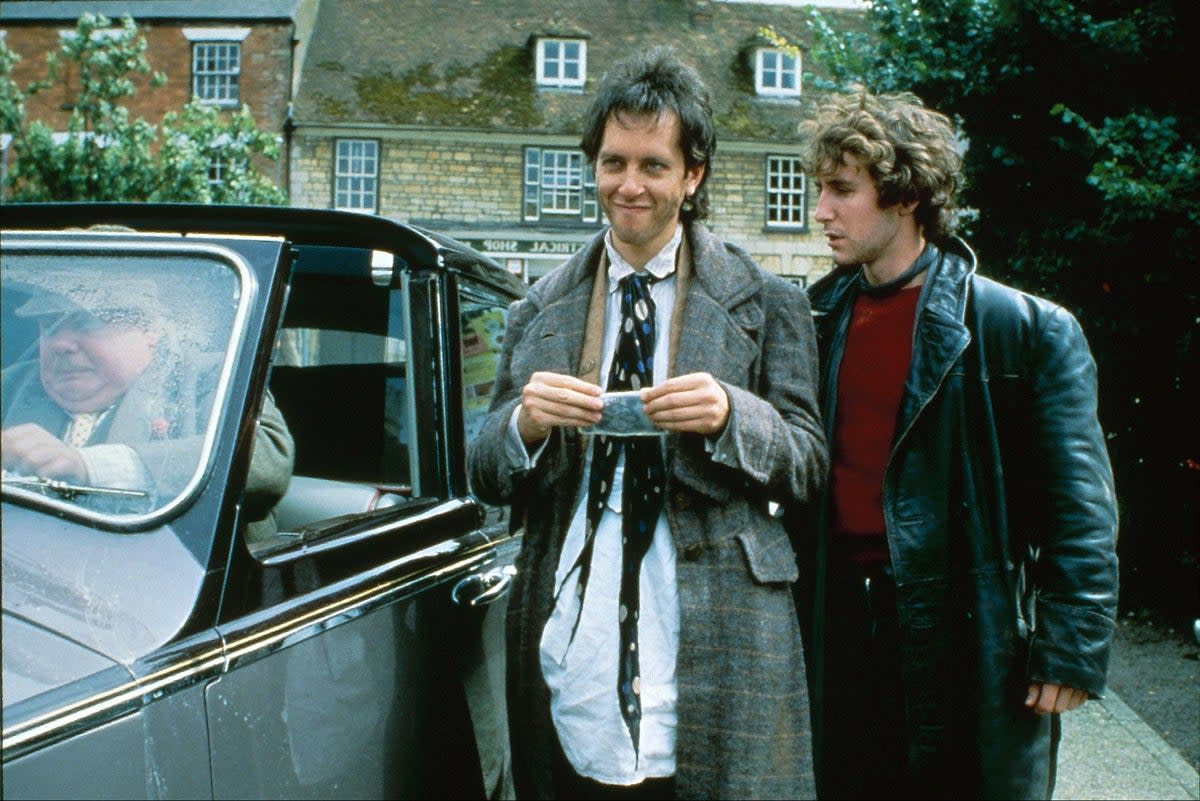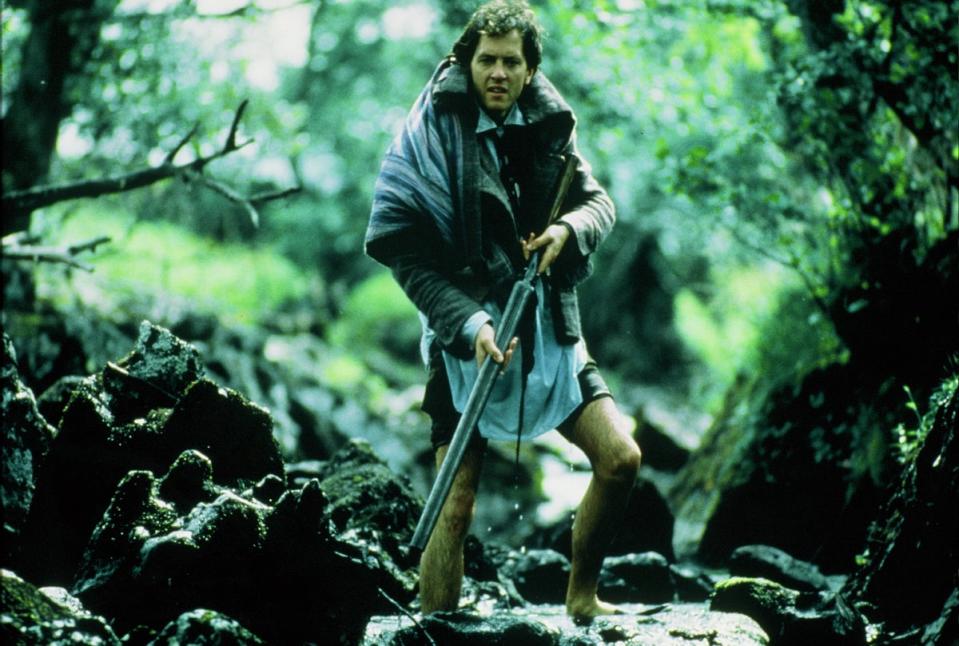Withnail and I: How a Beatle-funded comedy about alcoholic actors became a cult classic

- Oops!Something went wrong.Please try again later.
- Oops!Something went wrong.Please try again later.
- Oops!Something went wrong.Please try again later.
- Oops!Something went wrong.Please try again later.
Two men stride through a quaint Cumbrian village on an overcast Saturday afternoon, long overcoats flapping behind them. Newly and unusually flush with cash, the pair have been gifted money from a relative. Said relative has ordered them to get better equipped for a weekend in the countryside by buying Wellington boots. The men, however, have other ideas. Specifically: pub. Here, they drink themselves drunk until closing time, and then decide belatedly to line their stomachs in a tea room next door.
Only… the quaint village is unused to bohemian types in advanced states of disrepair, and does not take kindly to their presence. They are asked to leave – but the pair prove resistant. They want cake, the taller one bellows, and – in a line that would go on to become immortal in the canon of British cinema – “the finest wines known to humanity. We want them here, and we want them now”.
This was Withnail and I – a small film largely overlooked upon its 1987 cinematic release but now widely considered among the most-loved British motion pictures of all time, and surely the funniest. It would prove an impressive calling card for its two leading men, Richard E Grant and Paul McGann, a film both of them could trade off forever. It wasn’t an instant, era-defining hit, but instead, took time to find its audience, becoming a cult hit before ultimately being bestowed with classic status.
“When it first came out, there was nothing else quite like it, and the distributors really didn’t know what to do with it,” says Murray Close, the film’s on-set photographer whose prints from it still sell regularly to collectors around the world. Close has shot many movies over his illustrious career – The Shining, Jurassic Park, Batman – but, he suggests, “People just want to talk to me about Withnail. It’s always Withnail.”
The problem on its release, Close believes, was genre. What exactly was it? “Was it a story about drunken binges, or a story about friendship? Or was it about the end of the Sixties? It was a comedy without jokes,” he says, “and no women, either. The fact that it went on to be quite so loved probably says a lot about the English psyche.”
The actors are at the tail end of the swinging Sixties, whose dreams and ambitions were in danger of being snuffed out. It was about booze, too, and lots of it. And it was deeply personal to its first-time writer-director Bruce Robinson, who’d originally conceived it all the way back in 1970. He initially imagined it as a novel based on his own acting days in 1960s London, when he lived with a fellow jobbing actor whose personal regard to health and safety was often found wanting. Robinson had starred in Franco Zeffirelli’s 1968 adaptation of Romeo and Juliet, but didn’t much enjoy the exposure it brought him, and felt himself never cut out to be a hired hand.
He turned to script writing, convinced this was his true metier, and would nurture Withnail – now a screenplay – for the next 15+ years, while busying himself with other projects, one of which did come good: his 1985 screenplay for The Killing Fields, about the horrors of the Khmer Rouge regime in Cambodia. The film was an Oscar-winning hit, and suddenly Robinson had momentum. Immediately, he revived the cadaverous Withnail, and this time it fell into the hands of George Harrison, former Beatle turned film producer, who loved it, and gave him the green light.
After Daniel Day-Lewis turned down the titular role, the part of Withnail went to the unknown Richard E Grant, a young teetotal actor who at the time was grieving the death of his first child. The character of “I”, known as Marwood in the script, was taken by Paul McGann, a man of comparable handsomeness to Bruce Robinson, and who’d had some exposure via the BBC series The Monocled Mutineer a year earlier. Only Richard Griffiths, who played ageing thespian and incorrigible flirt Uncle Monty, was a known quantity, with previous roles in films like Gandhi and Gorky Park. Robinson himself had never directed before, and on the first day of filming admitted to his crew that he had no idea what he was doing. The shoot would prove problematical.

“It was co-produced by Denis O’Brien”, says Alex Godfrey, features editor at Empire magazine, “and O’Brien had made Monty Python films. He wanted Withnail to be a broad comedy, which of course it wasn’t. He was not really getting it at all, and just thought it depressing.”
The film, which took place in a dilapidated flat in Camden and a rundown cottage near Penrith, and featured a rusting Jaguar, a recently plucked chicken and a Camberwell carrot, was dimly lit and claustrophobic. It rained for much of the time, which only heightened the overriding sense of melancholy. But O’Brien was wrong: the film was funny. It was hysterical.
“It’s perhaps the funniest film I’ve ever seen,” says Charlie Higson, co-creator of TV’s The Fast Show, and latterly a novelist.
Though it tanked at the box office, its reputation would grow steadily over the years, in part because people like Higson never stopped recommending it to others. Today, it could hardly be held in higher esteem. A book published this month, Withnail & I: From Cult to Classic, edited by Toby Benjamin, features Q&As with its cast, as well as its director, and celebrates its ongoing cultural significance.
Charlie Higson contributes an essay on how, by not following the rules and by being quite so picaresque, it might just be the most re-watchable film ever made.
It was a freak of nature that seemed to come out of nowhere at a time when the UK was really struggling to make funny films
Charlie Higson
“It was a freak of nature that seemed to come out of nowhere at a time when the UK was really struggling to make funny films,” Higson says. “I think what I love about it most is that you can tell it wasn’t being manhandled by the Hollywood machine. The fact that it’s completely idiosyncratic is why it works.”
Shortly after its release, George Harrison’s company, Handmade, went out of business, and the film disappeared. It would only resurface several years later when a distribution company bought the rights, and released it first on video, and then DVD – and reaping the dividends that, in an ideal world, would have floated towards the director himself. “I’ve never seen a tuppence in royalties,” Robinson has said.
“We became aware at some point in the mid-1990s that people were beginning to watch it, and to talk about it,” says Murray Close. “But then it became this drinking game, which was not, I think, what Bruce had in mind for it at all.”
One feature of Withnail was its heavy alcohol and drug use, and so it became a film to actively participate in: drinking when the characters drank, smoking when they smoked. They drink wine, cider, gin, sherry, Scotch and ale, and when they run out of alcohol at home – and, more pertinently, when they can’t afford any more – Withnail turns to lighter fuel. Students – and Loaded magazine – loved it.
“I always thought that was missing the point,” Alex Godfrey argues, “because the film never did glamourise alcohol. You can smell the squalor of it, it’s all disgusting and repellent, they were living in terrible conditions, had no money, and all they wanted to do was escape.”

Over time, people were more drawn to it not just for the impeccable performances but its writing. While it is indeed full of memorably funny lines – “Get in the back of the van!”; “We’ve gone on holiday by mistake”; “Are you the farmer?” – it was also exquisitely literary. When Marwood, in voiceover, grows exhausted over Uncle Monty’s ramblings, he complains about having to listen to “yet another anecdote about his sensitive crimes, in a punt with a chap called Norman who had red hair, and a book of poetry stained with the butter drips from crumpets”.
Appreciation societies sprang up on Facebook and Mumsnet. It was referenced endlessly as a marker of good taste, and people like Kate Moss, Maxine Peake and Adam Buxton cited it as their favourite film. Philomena Cunk’s Diane Morgan claims it changed her life: “I started wearing a long check coat with a tie and waistcoat [like Withnail]. I knew all the lines. I could understudy any of the characters, and even now, if someone says: ‘It looks like it’s going to rain’, my brain will reply: ‘The sky’s beginning to bruise, night must fall and we shall be forced to camp’.”
Richard E Grant, forever defined by his debut turn, went on to become an A-list draw, but Paul McGann somehow didn’t – though he has remained in work ever since, not just as Doctor Who, but with recurring roles in TV series like Luther, Holby City and Our Mutual Friend. Richard Griffiths would die at 65 in 2013, while Robinson’s career, which should have soared, faltered. Charlie Higson concurs that Robinson always was “a maverick, and simply never designed to work within an industry”. The few films he’s made since – How to Get Ahead in Advertising in 1989, Jennifer 8 in 1992, and The Rum Diaries with Johnny Depp and, notably, Amber Heard in 2011 – compared poorly. He wrote a novel in 1998, The Peculiar Memories of Thomas Penman, and a sprawling biography about Jack the Ripper, They All Love Jack, in 2015. Otherwise: largely silence.
In From Cult to Classic, Robinson admits to being a “melancholy geezer”, but does suggest that he has been productive. “I’ve written 46 screenplays, a few at least as good, if not better, than Withnail, but they never got made.”
Charlie Higson: “I would very much like to read those screenplays.”
Now 77, he is reportedly working on a “big American project”, and still talks occasionally about reviving his two most famous characters, this time for the theatre. If he does continue to live under the shadow of his directorial debut, then there are surely worse places to reside.
“It would have been great to have had more Bruce Robinson classics,” Empire’s Alex Godfrey says, “but I genuinely think that when you make a film as good as this, and which endures forever, then that’s enough, no?”
Withnail & I: From Cult to Classic, edited by Toby Benjamin is out now

